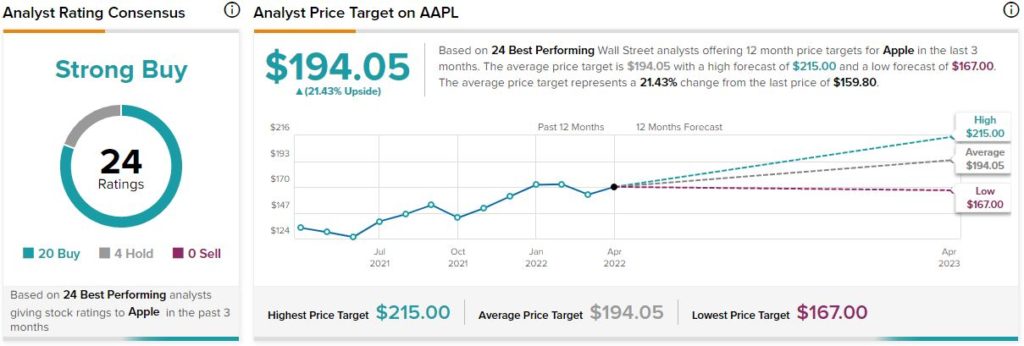Apple (AAPL) manufactures and sells a range of technology products, including smartphones, personal computers, tablets, and headphones. I am bullish on the stock.
Invest with Confidence:
- Follow TipRanks' Top Wall Street Analysts to uncover their success rate and average return.
- Join thousands of data-driven investors – Build your Smart Portfolio for personalized insights.
When Apple reports its quarterly data, it’s one of the most important events of any earnings season. After all, Apple is a giant in the technology sector.
Yet, even an industry giant is bound to have an earnings miss from time to time. The question is: how should investors define a miss? To a large extent, it depends on one’s interpretation of the results.
Investors weren’t too happy with Apple’s most recently reported earnings results, but actually, the quarterly data wasn’t bad. Nevertheless, the investing community found some pain points they didn’t like in the conference call.
Still, the overall financial picture looks positive for Apple. If the stock price slides further down, this could present an opportunity to pick up some shares at a nice discount.
A Company Record
$180 has been a stubborn resistance level for AAPL stock since December of 2021. Perhaps the bulls had hoped that Apple’s Fiscal 2022 second-quarter results would be the catalyst to push the stock above $180.
However, that didn’t happen, and AAPL stock actually fell moderately after the release of the earnings data. It wasn’t a catastrophic decline, but evidently, investors weren’t pleased.
Were the results really all that bad, though? Don’t just look at the price action of AAPL stock and jump to a negative conclusion. It’s important to always read both the press release and the conference call transcript whenever they’re available and form your own conclusions.
With all of that in mind, let’s start off with the top-line results for Apple’s second fiscal quarter of 2022. Right at the top of the company’s press release, Apple proudly announced that its quarterly revenue was up 9% year-over-year. Apple also announced that the revenue of $97.3 billion represented a March-quarter revenue record for the company.
So far, so good, as they say. Apple CFO Luca Maestri further observed that the company set fresh March-quarter company revenue records for its iPhone, Mac, Wearables, Home, and Accessories segments. Maestri also pointed out, “Continued strong customer demand for our products helped us achieve an all-time high for our installed base of active devices.”
In Apple’s conference call, Maestri touted Apple’s 15% year-over-year growth in Mac revenue, driven by strong demand for the company’s M1-powered MacBook Pro. This is great news, as it indicates that Apple isn’t entirely reliant on iPhone sales in the 2020s.
Acknowledging the Problem
Judging from these top-line results, it sure sounds like Apple was firing on all cylinders during the fiscal second quarter. What about the company’s bottom-line results, though?
No worries there – Apple did just fine. A quarterly datasheet reveals that during the company’s fiscal second quarter of 2022, Apple reported earnings per share (EPS) of $1.52 (diluted). That’s an improvement over the $1.40 recorded in the year-earlier quarter.
So, if Apple reported record performance in revenue generation, as well as a year-over-year improvement in EPS, what could investors possibly fret about?
Apparently, the issue had to do with Apple’s outlook regarding supply shortages. This is a problem for many technology hardware companies, and Apple is no exception to the rule.
In Apple’s conference call, Maestri acknowledged the painful truth concerning tech-component shortages and their likely impact on Apple’s future financial results.
“We’re having supply constraints that are caused by the COVID-related disruptions and by the silicon shortages, and that is what is creating the constraints,” Maestri admitted. “We expect them to be in the range of $4 billion to $8 billion. This is substantially larger than what we’ve had during the March quarter,” the CFO added.
Sometimes, honesty gets punished in the financial markets. Maestri couldn’t hide what everybody already knows: supply-chain bottlenecks will likely continue to weigh on Apple’s top and bottom lines. Investors might choose to send AAPL stock lower in the short term, but soon they should come back to their senses and return the share price to where I believe it belongs: much higher.
Wall Street’s Take
Turning to Wall Street, AAPL is a Strong Buy, based on 20 Buys and four Hold ratings assigned in the past three months. The average Apple price target is $194.05, implying 21.4% upside potential.

The Takeaway
It’s a shame that investors will sometimes punish a company just for admitting what people already know. Really, though, honesty is still the best policy, and it’s fine that Apple is acknowledging the likely fiscal impact of supply-chain constraints.
AAPL stock immediately fell in after-hours trading following the data release and conference call, and it is currently down 2% on the day. This is a short-term result and doesn’t reflect Apple’s true value as a company.
Just remember, the stock market is a weighing machine in the long term, so Apple’s solid fundamentals should be reflected in the share price eventually.
Therefore, don’t let short-term price moves shake you out of the trade when it comes to AAPL stock. Apple is still making progress in its revenue and profits and remains a technology-market icon.
Discover new investment ideas with data you can trust.
Read full Disclaimer & Disclosure









